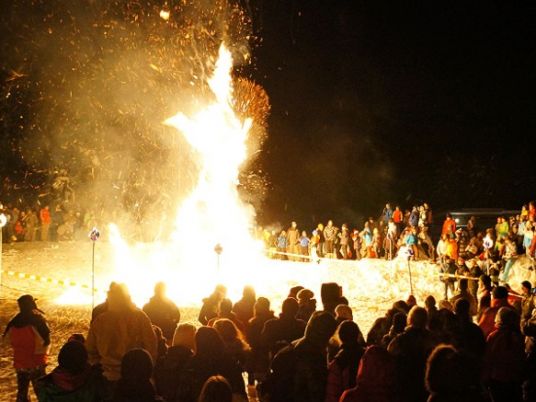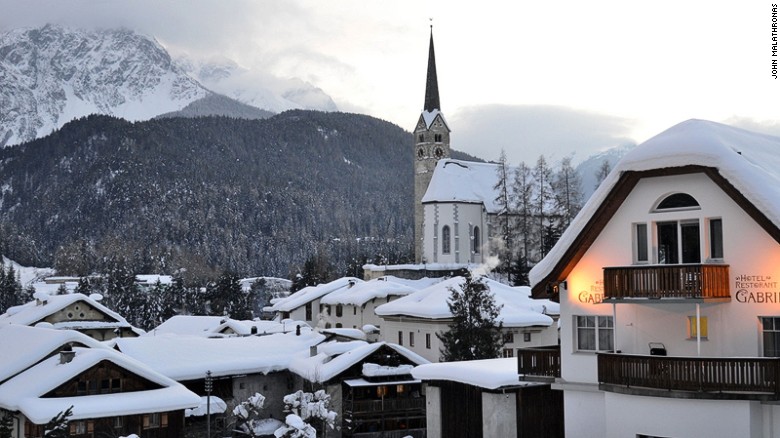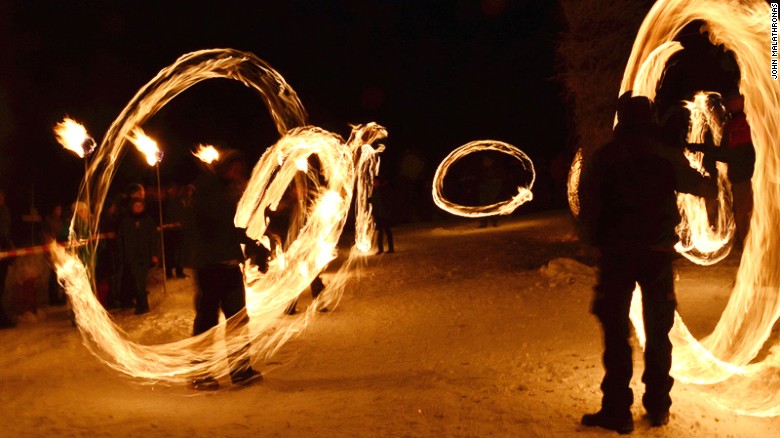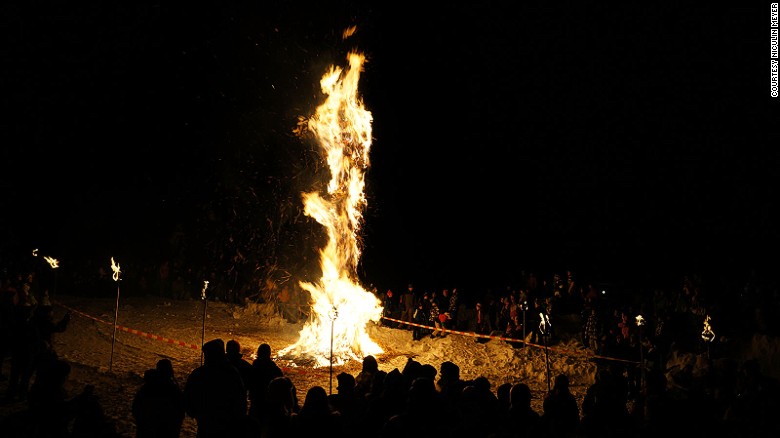
Scuol is one of those perfectly preserved semi-isolated communities in the Lower Engadine valley of Switzerland, separated from Italy by a series of Dolomite peaks.
Until the advent of the 19-kilometer Vereina Tunnel in 1999, the longest meter-gauge tunnel in the world, the passes to these villages were frequently unreachable in the winter.
It comes as no surprise that these isolated communities — Europe's version of Central Asia's tribal areas — have also kept customs that reach deep into their pagan past.
One of the most remarkable festivals in Europe takes place here on the first Saturday in February.
It's the burning of Hom Strom, Man of Straw in the local dialect, echoing pagan sacrificial traditions that sit uncomfortably with us today.
There are echoes of "The Wicker Man," the cult 1973 British horror film in which a cop searching for a missing girl stumbles into a pagan ritual that involves a giant burning wooden statue.
Only this time it's on ice.
Of course, unlike the film, no sacrifice will take place tonight.
Even the hymn sung during the ritual had to mollify the Catholic Church: "The flames that rise high/ bring praise to Our Lord" states the fourth stanza explicitly, just in case anyone was thinking of placating an old pagan snow god.
"But why February?" I ask my friend Niculin Meyer, born and bred in Scuol, as we walk around the village. It's -12 Celsius (10 Fahrenheit) at noon under a wintry, unwarming sun. "The snow won't melt for weeks."
Lost in the icy mists of time

The village of Scuol barely sees any sunshine in winter.
Meyer points at three Dolomite peaks: Piz Lischana (3105 meters), Piz San Jon (3093 meters) and Piz Pisoc (3173 meters) that rise like mischievous spirits in the east.
"In December and January the sun is low on the horizon and disappears behind those peaks in the early afternoon", he explains.
"Lower parts of Scuol only see the sun for two hours a day. If you live higher up you may get four.
"After February the sun moves higher and more to the south and it doesn't hide behind the mountains any more. Hom Strom is not celebrating the end of winter, but the reappearance of the sun in February."
Maybe it's this all-too-human longing for light, after enduring near polar circle darkness, that's the principal reason for the persistence of a ritual whose roots are lost in the icy mists of time.
Hom Strom is traditionally made from threshed, rye straw. It's the best straw for making rope, because of its long stalks.
It's no long found in the valley as people have switched to wheat and barley.
Only one farmer has kept a small rye plot that is paid for by the village, especially for Hom Strom.
It's 1:30 p.m. and everyone is assembled in the central square.
The work is divided among the schoolchildren. The youngest kids fetch straw to the square from a barn downhill, where a woman dispenses the bundles to the kids. The older ones serve cakes and non-alcoholic punch to the assembled guests and villagers.
The oldest — males and females aged between 18 to 21 — twist the straw strands into a thick twine and wind it around a pole with a winch, guided by experienced elders.
By the time they finish, three hours later, the mast will be about one meter thick and weigh around half a ton.
Molotov cocktails

The boys guarding the Hom Strom replace their whips with fireballs after nightfall, rendering the spectacle even more primitive and otherworldly.
Young teenage boys traditionally crack whips, keeping vigil while also showing off. No one must come near Hom Strom and light it prematurely before the designated hour of 8 p.m.
"Even as late as 30-40 years ago, there were several rye farms and every district of Scuol built their own Hom Strom," says Meyer.
"There was a lot of competition as to which one is bigger or burned the longest. Children tried to sabotage the Hom Strom of their opponents."
Inadvertently touching upon the Swiss fixation with punctuality, Meyer remembers: "It's a great shame to have your Hom Strom burnt before 8 p.m.
"I remember in 2006 when kids with Molotov cocktails came from Sent, the next village, and set Hom Strom ablaze.
"We tried to build another one quickly, but it was small and burnt almost immediately. Next year, expecting a similar mission, we built a decoy; the Sent boys burnt the fake one, but in the evening we brought the real one out and all was well."
At around 6 p.m. a horse carriage arrives to carry this year's Hom Strom to the Gurlaina meadow, where it will soon be torched. This is a barren tract outside the village proper and the comparison with the Biblical crucifixion site Calvary is hard to dismiss.
By 7:30 p.m. the whole village has gathered around the pole.
The boys' whips have been replaced by fireballs rendering the spectacle even more primitive and otherworldly.
The temperature is a glacial -25°C/-13°F and yet everyone is patiently rooted to their spot, waiting silently for the designated hour.
When the clock strikes eight, the fireballs hit the straw man and the crowd comes alive.
Their future depends on the whims and fancies of the bonfire. The longer it burns, the better the summer season will be.
The wind pattern and the flame direction matter, too, and everyone is looking for subtle signs I cannot comprehend.
As the fire rises high and the congregation hit the low notes of the Hom Strom hymn, I half-close my eyes and transport myself 1,000 years back.
The bonfire lasts for 15 minutes. There are smiles all around. The summer will be good.

The Hom Strom burns for roughly 15 minutes. There are smiles all round. The summer will be good.
Visiting Scuol
The quickest way to visit Scuol is by train from Zurich changing at Landquart (2 hours, 38min; $33).
The timing is such that the connection is almost instantaneous.
There's an extensive ski area at Scuol with 80 kilometers of runs (day pass $55).
There are also natural spa springs, accessed via covered galleries from three hotels: Belvair (Stradun 169, Scuol; +41 81 861 25 00), Belvedere (Stradun 330, Scuol; +41 81 861 06 06) and Guardaval (Vi 383, Scuol; +41 81 861 09 09).




